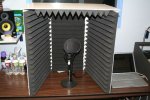calimoose
New member
I'm working on a DIY solution for my needs (where I'm in a small apartment where acoustic treatment isn't possible and the layout isn't sound-friendly). Basically, it's a way to isolate my condenser mic using panels that I can easily fold and store away for later use (hence NOT a booth, which given my space limitations would not be very possible).
Just curious to see if anyone else has used similar treatment, particularly if they use a condenser on a mic stand.
Here's something very similar to what I'm pursuing:
What do you guys think? Creative acoustic treatment in a tiny space? Or useless gimmick?
Just curious to see if anyone else has used similar treatment, particularly if they use a condenser on a mic stand.
Here's something very similar to what I'm pursuing:

What do you guys think? Creative acoustic treatment in a tiny space? Or useless gimmick?



